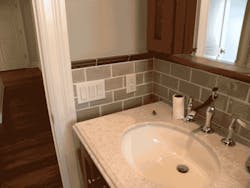How well do you know the Code? Think you can spot violations the original installer either ignored or couldn't identify? Here's your chance to moonlight as an electrical inspector and second-guess someone else's work from the safety of your living room or office. Brian, who has a knack for finding shoddy electrical work, did the dirty work and found this mess. Now it's your turn to identify the violation.
Find the Answer
This photo shows a violation of the rule given in 406.11. This new requirement was added to the 2008 version of the NEC. It requires all receptacles covered by 210.52 to be tamper-resistant. The GFCI receptacle in this new bathroom is not of the tamper-resistant type.
406.11 simply and succinctly says, "In all areas specified in 210.52, all 125-volt, 15 and 20 ampere receptacles shall be listed tamper-resistant receptacles." Full understanding of the widespread and all encompassing nature of this change becomes apparent when one reviews the rules given in 210.52.
As most are aware, 210.52 provides a variety of requirements related to dwelling unit receptacle outlets. This section states where, when, and how many receptacles must be located in virtually all rooms, spaces, and areas within a dwelling unit. Additionally, it identifies those receptacles that may not be considered as satisfying the rule of this section, which is essentially intended to ensure that there is an adequate number of accessible receptacle outlets available in habitable rooms to minimize the need for extension cords and/or plug strips within a dwelling unit.
210.52 also gives requirements for receptacle outlets in those dwelling unit rooms and areas that would not be viewed as "habitable rooms," such as the basement, kitchen, garage, etc., and bathrooms, which is covered in part (D) of 210.52.
It should be noted that while 210.52(D) only requires one 15A or 20A, 125V receptacle within 3 ft of each sink in the bathroom, the requirement in 210.8(A)(1), which calls GFCI protection of receptacles in dwelling unit bathrooms, would apply to all 15A and 20A, 125V receptacles in a dwelling unit bathroom, and GFCI protection must be provided for any such receptacle installed there. When combined with the rule of 406.11, any 15A or 20A, 125V-rated receptacle installed in a dwelling unit bathroom would have to be GFCI protected and be a listed tamper-resistant receptacle.
